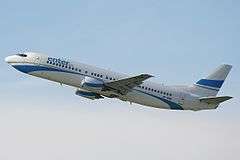Rate of climb


In aeronautics, the rate of climb (RoC) is an aircraft's vertical speed – the rate of positive altitude change with respect to time or distance.[1] In most ICAO member countries, even in otherwise metric countries, this is usually expressed in feet per minute (ft/min). Elsewhere, it is commonly expressed in metre per second (m/s). The rate of climb in an aircraft is indicated with a vertical speed indicator (VSI) or instantaneous vertical speed indicator (IVSI).
The rate of decrease in altitude is referred to as the rate of descent or sink rate. A decrease in altitude corresponds with a negative rate of climb.
Speed and rate of climb
There are a number of designated airspeeds relating to optimum rates of ascent, the two most important of these are Vx and Vy.
Vx is the indicated forward airspeed for best angle of climb. This is the speed at which an aircraft gains the most altitude in a given horizontal distance, typically used to avoid a collision with an object a short distance away. By contrast, Vy is the indicated airspeed for best rate of climb.,[2] a rate which allows the aircraft to reach a specified altitude in the minimum amount of time regardless of the horizontal distance required. Vx is always lower than Vy. Maximum power and climb rates are typically specified as normal operating procedures for small aircraft, such as a Cessna 150, but only during emergencies for large jet liners.
Climbing at Vx allows pilots to maximize altitude gain per horizontal distance. This occurs at the speed for which the difference between thrust and drag is the greatest (maximum excess thrust). In a jet airplane, this is approximately minimum drag speed, occurring at the bottom of the drag vs. speed curve.
Climbing at Vy allows pilots to maximize altitude gain per time. This occurs at the speed for which the difference between engine power and the power required to overcome the aircraft's drag is the greatest (maximum excess power).[3]
Vx increases with altitude and Vy decreases with altitude until they converge at the airplane's absolute ceiling, the altitude above which it cannot climb using just its own lift.
A small four-seat aircraft like the Cessna 172 has a Vy of 75 KIAS [4] providing a climb of rate of 721 ft/min. A large passenger jet, the Airbus A320, has a Vx of 220KIAS and a Vy of 270KIAS.